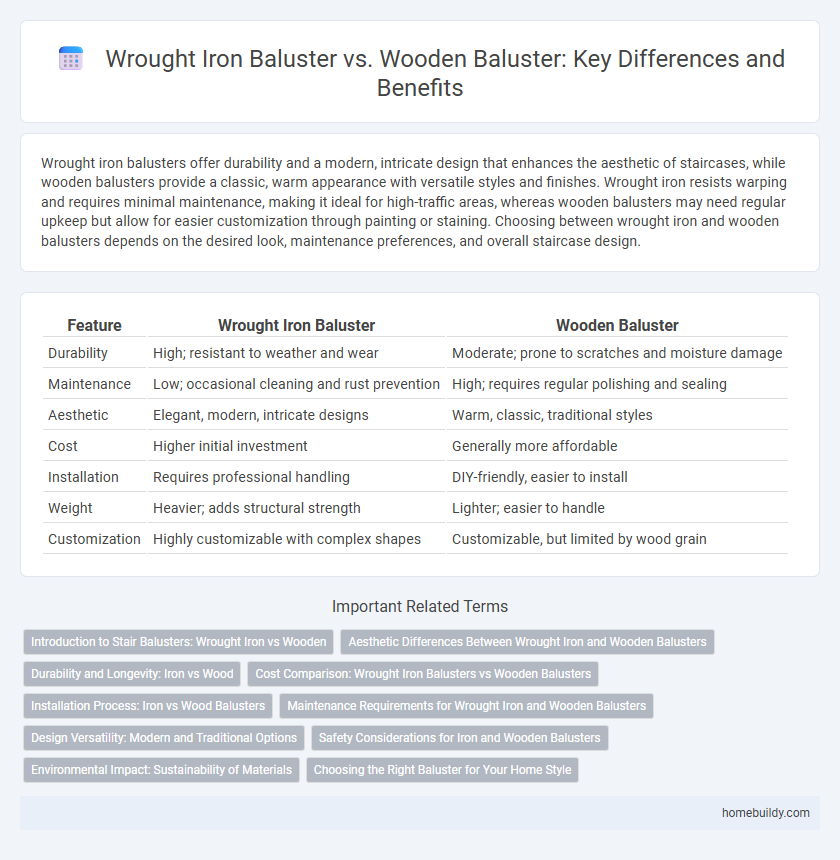Wrought iron balusters offer durability and a modern, intricate design that enhances the aesthetic of staircases, while wooden balusters provide a classic, warm appearance with versatile styles and finishes. Wrought iron resists warping and requires minimal maintenance, making it ideal for high-traffic areas, whereas wooden balusters may need regular upkeep but allow for easier customization through painting or staining. Choosing between wrought iron and wooden balusters depends on the desired look, maintenance preferences, and overall staircase design.
Table of Comparison
| Feature | Wrought Iron Baluster | Wooden Baluster |
|---|---|---|
| Durability | High; resistant to weather and wear | Moderate; prone to scratches and moisture damage |
| Maintenance | Low; occasional cleaning and rust prevention | High; requires regular polishing and sealing |
| Aesthetic | Elegant, modern, intricate designs | Warm, classic, traditional styles |
| Cost | Higher initial investment | Generally more affordable |
| Installation | Requires professional handling | DIY-friendly, easier to install |
| Weight | Heavier; adds structural strength | Lighter; easier to handle |
| Customization | Highly customizable with complex shapes | Customizable, but limited by wood grain |
Introduction to Stair Balusters: Wrought Iron vs Wooden
Wrought iron balusters offer durability, intricate designs, and low maintenance, making them ideal for both modern and traditional staircases. Wooden balusters provide warmth and classic appeal, with customization options through staining and carving, but may require more upkeep due to susceptibility to wear and moisture. The choice between wrought iron and wooden balusters impacts not only aesthetics but also longevity and maintenance needs in stair design.
Aesthetic Differences Between Wrought Iron and Wooden Balusters
Wrought iron balusters offer a sleek, elegant appearance with intricate designs that enhance modern and traditional staircases, while wooden balusters provide a warm, classic charm with natural grain patterns and customizable stains or paints. The metallic finish of wrought iron adds a touch of sophistication and durability, making it ideal for contemporary spaces, whereas wooden balusters evoke a timeless, cozy ambiance suited for rustic or classic interiors. Choosing between wrought iron and wood balusters depends on the desired aesthetic impact, architectural style, and personalization preferences.
Durability and Longevity: Iron vs Wood
Wrought iron balusters offer superior durability and longevity compared to wooden balusters, resisting warping, cracking, and insect damage common in wood. Iron balusters maintain structural integrity over decades with minimal maintenance, making them ideal for both indoor and outdoor staircases. Wooden balusters, while aesthetically warm, often require frequent sealing and repairs to prevent deterioration from moisture and environmental factors.
Cost Comparison: Wrought Iron Balusters vs Wooden Balusters
Wrought iron balusters generally cost between $30 and $70 per piece, depending on design complexity and finish, while wooden balusters range from $10 to $40 each, influenced by wood type and craftsmanship. Installation expenses for wrought iron can be higher due to weight and specialized labor, whereas wooden balusters often allow for quicker, less costly installation. Long-term durability and maintenance also impact overall cost, with wrought iron offering greater resilience but potentially requiring periodic rust prevention treatments compared to the more frequent refinishing required for wooden balusters.
Installation Process: Iron vs Wood Balusters
Wrought iron balusters require precise measurement and alignment due to their rigidity and custom shapes, often necessitating specialized tools for cutting and drilling during installation. Wooden balusters offer more flexibility and ease of installation, as they can be trimmed on-site and attached using basic carpentry tools, making adjustments simpler. The installation of wrought iron balusters typically demands experienced craftsmanship to ensure secure fitting and aesthetic uniformity, while wood balusters accommodate DIY installations with fewer technical challenges.
Maintenance Requirements for Wrought Iron and Wooden Balusters
Wrought iron balusters require minimal maintenance due to their corrosion-resistant coatings but benefit from periodic inspections and touch-ups to prevent rust and maintain their appearance. Wooden balusters demand regular upkeep, including sanding, staining, or painting to protect against moisture, warping, and insect damage, especially in outdoor settings. Both materials benefit from prompt repairs to extend lifespan and preserve structural integrity in stair railing systems.
Design Versatility: Modern and Traditional Options
Wrought iron balusters offer extensive design versatility with intricate patterns and a sleek, modern aesthetic that complements contemporary and traditional staircases alike. Wooden balusters provide warmth and classic charm, available in various shapes and finishes to match rustic, colonial, or Victorian styles. Both materials enable customization, but wrought iron excels in durability and detailed craftsmanship for statement stair designs.
Safety Considerations for Iron and Wooden Balusters
Wrought iron balusters offer superior strength and durability, reducing the risk of breakage and enhancing overall stair safety compared to wooden balusters, which can weaken over time due to moisture and pests. Iron balusters typically meet stricter building codes for spacing and load-bearing capacity, providing reliable support on staircases. Wooden balusters require regular maintenance and inspections to prevent splintering, warping, or loosening, which can compromise safety.
Environmental Impact: Sustainability of Materials
Wrought iron balusters offer long-lasting durability and are often made from recyclable materials, reducing waste and environmental impact over their lifecycle. Wooden balusters, while biodegradable and sourced from renewable forests, can contribute to deforestation if not harvested sustainably and often require chemical treatments that may harm the environment. Choosing sustainably sourced wood certified by organizations such as FSC or recycled wrought iron can significantly enhance the eco-friendliness of stair baluster installations.
Choosing the Right Baluster for Your Home Style
Wrought iron balusters offer a sleek, durable option with intricate designs ideal for modern or industrial home styles, while wooden balusters provide warmth and traditional charm best suited for classic or rustic interiors. Consider the architectural elements and color palette of your home when selecting between metal and wood to ensure seamless integration. Durability and maintenance requirements also influence the choice, as wrought iron resists wear better, whereas wood may need regular refinishing.
wrought iron baluster vs wooden baluster Infographic

 homebuildy.com
homebuildy.com